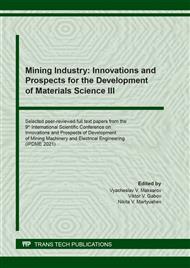[1]
Y. Meng, J. Deng, D. Ge, J. Wu, W. Sun, R. Wang, Surface textures fabricated by laser and ultrasonic rolling for improving tribological properties of TiAlSiN coatings, Tribology International (2021) 107248.
DOI: 10.1016/j.triboint.2021.107248
Google Scholar
[2]
Y.O. Kosminska, G.S. Kornyushchenko, Y.V. Gannych, V.I. Perekrestov Fabrication and physical properties of coatings belonging to W, Ta, Hf, Ti, Mo, Cr, Al and C based multicomponent systems Journal of Superhard Materials 42(6) (2020) 388-395.
DOI: 10.3103/s1063457620060040
Google Scholar
[3]
C. Y. Lu, W. Diyatmika, B. S. Lou, J. W. Lee Superimposition of high power impulse and middle frequency magnetron sputtering for fabrication of CrTiBN multicomponent hard coatings Surface and Coatings Technology 350 (2018) 962-970.
DOI: 10.1016/j.surfcoat.2018.03.045
Google Scholar
[4]
K. Krishnaveni, T. S. Narayanan, S. K. Seshadri Electrodeposited Ni–B coatings: Formation and evaluation of hardness and wear resistance Materials chemistry and physics 99(2-3) (2006) 300-308.
DOI: 10.1016/j.matchemphys.2005.10.028
Google Scholar
[5]
V. Vitry, A. Sens, F. Delaunois, Comparison of various electroless nickel coatings on steel: structure, hardness and abrasion resistance Materials Science Forum 783 (2014) 1405-1413.
DOI: 10.4028/www.scientific.net/msf.783-786.1405
Google Scholar
[6]
U. S. Waware, A. M. S. Hamouda, N. P. Wasekar, Mechanical properties, thermal stability and corrosion behavior of electrodeposited Ni-B/AlN nanocomposite coating Surface and Coatings Technology 337 (2018) 335-341.
DOI: 10.1016/j.surfcoat.2018.01.028
Google Scholar
[7]
D. Li, B. Li, S. Du, W. Zhang Synthesis of a novel Ni–B/YSZ metal-ceramic composite coating via single-step electrodeposition at different current density Ceramics International 45(18) (2019) 24884-24893.
DOI: 10.1016/j.ceramint.2019.09.121
Google Scholar
[8]
R. A. Shakoor, R. Kahraman, U. S. Waware, Y. Wang, W. Gao, Synthesis and properties of electrodeposited Ni–B–CeO2 composite coatings Materials & Design 59 (2014) 421-429.
DOI: 10.1016/j.matdes.2014.03.024
Google Scholar
[9]
M. S. Mehr, A. Akbari, E. Damerchi Electrodeposited Ni-B/SiC micro-and nano-composite coatings: A comparative study Journal of Alloys and Compounds 782 (2019) 477-487.
DOI: 10.1016/j.jallcom.2018.12.184
Google Scholar
[10]
S. J. Bull Failure modes in scratch adhesion testing Surface and Coatings Technology 50(1) (1991) 25-32.
DOI: 10.1016/0257-8972(91)90188-3
Google Scholar
[11]
S. Kataria, N. Kumar, S. Dash, R. Ramaseshan, A. K. Tyagi Evolution of deformation and friction during multimode scratch test on TiN coated D9 steel Surface and Coatings Technology 205(3) (2010) 922-927.
DOI: 10.1016/j.surfcoat.2010.08.060
Google Scholar


